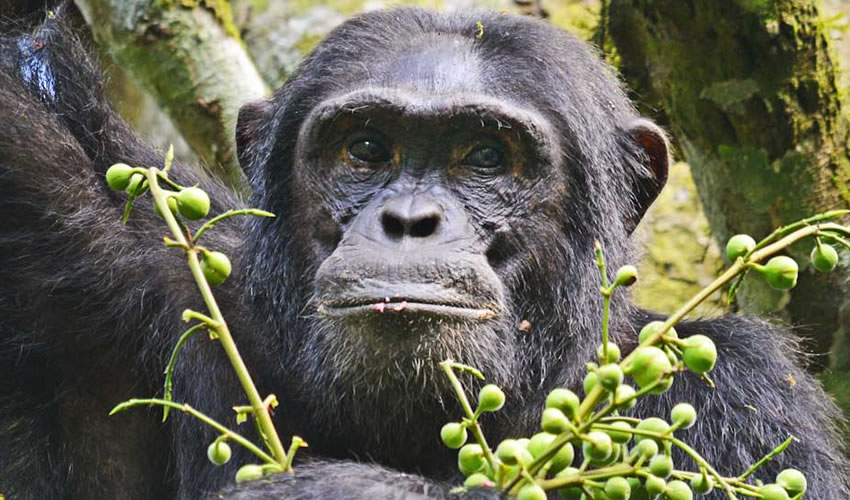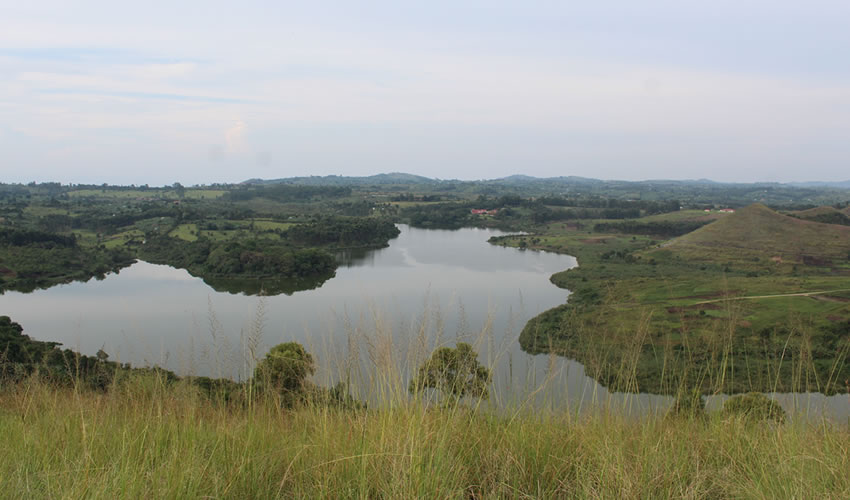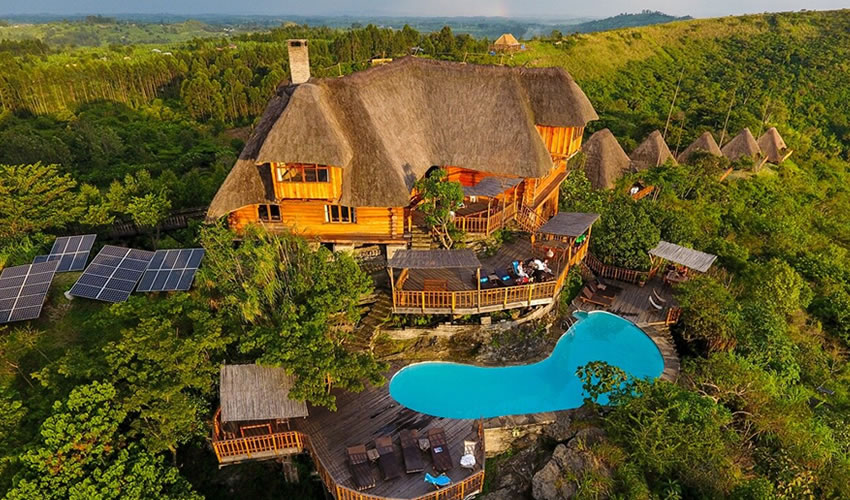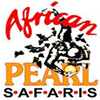Kibale Forest National Park is located in the western region of Uganda covering parts of Fort Portal city which is known as a tourism and the most beautiful city in Uganda any one would like to visit in the world. The park protects the moist evergreen forest covering 795km2 in size. It lies between 1,100m to 1,590m above sea level. Kibale is one of national parks remaining with both lowland and montane forest in East Africa sustaining the last significant expanse of pre-montane forest.
The park sustains 70 species of mammals with 13 primate’s species including the chimpanzees, Olive Baboons, Bush babies / Demidoff Galago, Black and White colobus, Potto, Vervet monkeys, Blue monkeys, and Grey Cheeked mangabey among others. It is also a well known destination for bird watchers containing 375 species of birds like Green-breasted pitta, African pitta, Abyssinian groundthrush, Crowned eagle, Dusky crimsonwing, Black-capped apalis, Collared apalis, Purple-breasted sunbird, Black bee-eater, Yellow spotted nicator, Little greenbul, Black-eared groundthrush, Brown-chested alethe, Yellow-rumped tinker bird and Blue-breasted kingfisher.

Kibale National Park is well known for Chimpanzees and contains over 1500 chimpanzee individuals more than any other park in East Africa making it the best destination for chimpanzee tracking in East Africa and Africa at large. With lush tropical rain forest and a fascinating diversity of animals, Kibale National Park is home to one of the most beautiful and stunning natural forests in Uganda. Being home to vast species of primates, Kibale Forest National Park is one of the most visited tourist destinations in Uganda and especially popular for Chimpanzee tracking tours, where tourists get to encounter large numbers of chimpanzees in their natural habitat.
The park borders Queen Elizabeth National Park in the southern part forming the wildlife corridor which stretches 180km from Kibale to Queen Elizabeth National Park and it has increased the presence of certain species of mammals like elephants, buffalos, leopards, warthogs, bush pigs, golden cats and duikers in Kibale National Park.
Kibale National Park is 24 Km east of the Rwenzori Mountains Foothills and 20Km south-east of Fort Portal town in Western Uganda. The park occupies four districts: Kabarole, Kyenjojo, Kamwenge and Kasese. From Kampala, Visitors to Kibale must pass via Fort Portal on either the Mubende or the Kasese highways. A little used, alternative route passes through Ibanda and Kamwenge from Mbarara.
The park was gazzeted in 1932 as a logged forest reserve by the British and it was used to harvest coffee and extract hardwood from the forest along with the existence of the 13 species of the primates. The British planted the exotic trees after the hardwoods were wiped out in the forest. In 1950, the need and interest of the hardwood was increased after the emergency of Kilembe copper mines in Kasese. The British them with satinwood, mahogany, Elgon Olive, pines and Eucalyptus. Then in 1993, the forest reserve was upgraded into Kibale national park and after in 1994, the Uganda National Parks (UNP) took over the management of this forest and lastly in 1996, Uganda Wildlife Authority (UWA) took over up to date. Currently, it protects 351 tree species and most especially to protect our closest creatures to human beings known as the Chimpanzees which is most important for your visit to this mighty National Park.
Kibale National Park is also the location of the Makerere University Biological Field Station.
MAIN TOURISM ACTIVITIES IN KIBALE FOREST NATIONAL PARK
-
Chimpanzee Tracking
Chimpanzee tracking starts at 8.00a.m with the briefing at Kanyanchu Tourist Center and it lasts for 2-4 hours. The activity is very popular with visitors highlighting the diversity of primates within the forest. Although it is not guaranteed, the chances of viewing the Chimps are in your favor of over 90% chance. This walk is restricted to 12 people per group of individuals. Both morning and afternoon sessions are conducted. You will be escorted by the ranger guides and upon finding the chimpanzees; the clients are subjected to 1 hour of staying and viewing them. So, you will learn their behaviors and especially the play, feeding habit among others.
The Kanyanchu Tourist Center is where all activities begin. The friendly and experienced ranger guides will share their knowledge on forest species with you. Some 12 primate species, elephants, butterflies, reptiles, amphibians, trees, medicinal plants, and of course, habituated chimpanzee’s are to be found here.
-
Chimpanzee Habituation Experience
The Chimpanzee habituation experience is so unique compared to chimpanzee tracking. It starts with the briefing at Kanyanchu Tourist Center and visitors will be escorted by the group of ranger guides together with researchers into the forest unlike chimpanzee tracking where visitors are only escorted by guides. You set off between 6:00am and 6:30am to where the chimpanzees built their nests on the previous night and upon meeting them, you will spend 4 hours interacting with these closest creatures to human beings. Dawn is just breaking and the chimpanzee community you are going to be with the rest of the day as they rise from their sleep until they build their nest in the evening. Amazingly, you will see chimpanzees copulating, breastfeeding, feeding, patrolling, hunting, resting and later on at around 7 pm, building new nests where they are to stay during the night. So at the end of the day your camera will full of chimpanzee photos, videos, and you will get to learn to identify them as individuals by their markings, sometimes scars and other unique features that make them stand from rest. Besides everything described there are the most colorful butterflies, plants and trees that will amaze you –the setting is simply awesome.
-
Nature Walk and Forest Hike
The seasonal 12 km hike that is restricted to the dry season (mid-Nov to Feb ad June to Sept). It highlights the diverse habitats of the park including tropical rain forest, riverine forest, swamp and grassland.
You will have the chance to see a variety of birds and monkeys and perhaps duikers and bush pigs. The walk begins at 8.00am from Kanyanchu finishing at the elephant wallow around 2.00pm. Bring snacks and book lunch at the Community canteen on your return. Black and White Colobus Monkey spotted in at this time. Beside hikes, both day and night nature walks are commonly done in Kibale National Park. It exposes clients to flora and fauna. The ranger guide will describe the various plant species with their uses and especially medicinal plants, various birds species will be spotted during the day and night nature walks for the nocturnal. You will also have chance to spot primates like white and black colobus monkey, Olive baboons, Vervet monkeys, Blue monkeys, and Grey Cheeked mangabey. For night nature walks, the potto, bushbaby, nightjar, cricket, serval cat and tree hyrax can be spotted. The nature walks take 2-6 hours and they start from Kanyanchu Tourist Center or Sebitoli.
Bigodi Wetland natures walk enable visitors to see unique flora and fauna. it is a fascinating area, located in Magombe swamp. this area is recognized for a extensive array of biodiversity among which are several primates species like the red colobus monkey, baboon, black & white colobus monkey, blue monkey grey cheeked, mangabey, vervet monkey, red tailed monkey and the L’Hoest monkey
-
Bird Watching at Kibale Forest National Park
In addition to large numbers of primates, Kibale National Park is also home to 375 species of birds including 138 bird species at the Bigodi Wetland Sanctuary, the rare ones such as the White-collared Oliveback, Papyrus Gonolek, and Papyrus Canary White-winged Warbler among many others are also found at this beautiful wetland. Bird watching tours start at 7:00am at Kanyanchu for the morning session and around 3:00pm for the evening one. Other bird species to marvel at Kibale National Park include; the White-tailed Ant-thrush, Brown-backed Scrub-robin, White-spotted Flufftail, Yellow-spotted Barbet, Hairy-breasted Barbet, Yellow-billed Barbet, Western Nicator, Brown-throated Wattle-eye, Superb Sunbird, Brown-crowned Tchagra, Bocage’s Bush-shrike, Black Bishop, Grey-winged Robin-chat, Black-and-white Shrike-flycatcher, White-breasted Negrofinch among others.
-
Crater Lake Tour

The guided walk in the crater lakes area of the park for outstanding views and cultures offers unforgettable experience. The so called top of the world is an amazing point for viewing various attractions in minutes while in your Kibale National Park visit. Kabarole district which covers parts of Kibale National Park has the highest numbers of crater lakes in Uganda totaling to (52) crater lakes. It is the highest point in one of the crater lakes hence the name “top of the world” and it is 20km from Fort Portal town. While at this point, you will be able to see Ruwenzori Mountain ranges, Kibale National Park, Lake George and three crater lakes (Nyamirima, Nyinabulitwa and Nyabikere).
The carter walk in the western parts of Fort Portal town also offers a visit to Amabere Ga Nyina Mwiru which has a strong cultural attachment to the Batoro people. Geographically, they are Stalactites and stalagmites which are formed as a result of the constant deposition of calcium carbonate and other minerals but this is not the case to the Batoro people and they believe that these caves are breasts of their young girl called Nyina Mwiru. The breasts were cut by the King when Nyina Mwiru was sought to give birth to the son who will topple the King from power. This is amazing place.
ACCESS / HOW TO GET THERE
BY ROAD
It costs over 300km to drive from Kampala to Kibale National Park via Mityana only for 5 hours. So you will marvel through the towns and roads of Mityana, Mubende and Fort Portal city which is the gateway to most tourism attraction in western Uganda.
Optionally, one can drive through Kampala, Masaka, Mbarara, Ibanda and Kamwenge road to Kibale National Park. Through this highway, you can visit equator at Kayabwe, Igongo cultural centre in Mbarara and if time allows you, can also visit Lake Mburo National Park. It will take you 7 hours drive to reach Kibale National Park and 427km of fuel.
BY AIR
This is the shortest means of transport to reach Kibale Forest National Park. So our clients can fly from Entebbe international airport to Kasese airstrip using the available domestic flights. It takes only 2 hours of flying in between. Our driver guide will be ready at Kasese airstrip to pick you up and transfer to Kibale National Park for only 1 hour.
WHERE TO STAY
HIGH END AND LUXURY LODGES

- Kyaninga Lodge
- Aramaga Rift Valley Lodge
- Ndali lodge
- Papaya Lake Lodge
- Crater Safari Lodge
MID RANGE LODGES
- Primate Lodge Kibale
- Kibale Forest Camp
- Mountains of the Moon Hotel
- Fort Motel
BUDGET FACILITIES
- Chimpanzee Forest Guesthouse
- Kibale Safari Lodge
- Rweteera Safari Park
- Isunga Lodge
- Chimp Nest Lodge
